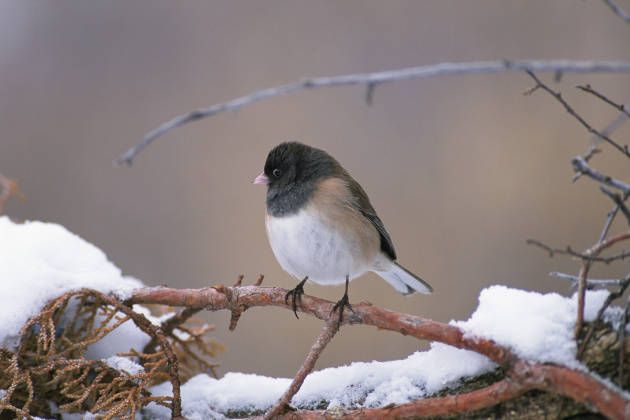
It seems that at least a few birds survived the cold snap and the snow that followed, as they’ve started coming to my feeder in numbers.
It took the first birds about 24 hours to turn up. In my case, this year, they were Dark-eyed Juncos in a full candy-box of their color combinations — if the candy box was filled entirely with liquorice and strawberry creams. That would be pretty grim in a candy box, but at a bird feeder it’s wonderful. I find the Dark-eyed Junco complex to be endlessly fascinating, with a stark simplicity that to me makes them among the most beautiful sparrows combined with a variability that keeps things interesting. I continue in my endless, fruitless quest to get a non-crappy photo of as many different-looking Juncos, from Slate-colored to Pink-sided, in one shot as I can.
It doesn’t surprise me that the Juncos made it first. While bird feeders are not common in my neighborhood, weedy unmown lawns are, full of seeds for a discerning ground-feeder. A handful were patronizing my lawn even before the feeder went up, and no doubt noticed it right away.
The more traditional scouts of the bird world, Black-capped Chickadees, arrived within hours after the Juncos. I had hoped that in the circumstances, a few Mountain Chickadees might turn up with them, but no such luck, though I know that the species occurs on Mount Sentinal less than a mile from here. Apparently the weather hasn’t been quite enough to force them into altitude-based migration yet. Nor were the Black-capped Chickadees accompanied by Red-breasted Nuthatches, as they have been in other years. Red-breasted Nuthatches are another feeder favorite, and always feel like a special treat even though they’re relatively common in Missoula. I hope they turn up soon.
Before the day was out, another sparrow had noticed that the Juncos were on to something good and staked the place out. It wasn’t quite as exciting as last year’s Harris’s Sparrow, but the Song Sparrow who I spotted in the late afternoon is a very handsome bird. I choose to believe that this is the bird that delighted me by singing under the Madison Street Bridge this summer, producing an echoing, amplified song that was all the more beautiful for its distortions. But who knows.
As usual, the Northern Flickers that arrived the next day were shy and stand-offish, bolting at the first hint that I was opening the door for a refill. I wish they were more confiding, as they’re the only birds big enough to hold off the fat, obnoxious squirrels who also showed their faces on the second day. In the absence of big avenging woodpeckers, I was forced to unleash the hound (who stands about as much chance of actually catching a squirrel as he does of flying, but he made my point.)
Still no Gray-crowned Rosy-finch, though.
Photo courtesy of USFWS. You didn’t think I took that, did you?











Juncos are so beautiful. I didn’t get to see them very often during my times in Michigan, and each encounter was cherished, for the very same reasons you state: the simplicity of their soft and subtle colours, and the vagrancy potential.
About those squirrels: I am not entirely sure you’d be happy if you watched your hound actually catch and kill one.All the squirrels are is hungry, there’s nothing wrong with that with the sole exception of a birder’s perspective.
I appreciate your concern for the squirrels, Jochen, but there are a couple of things you should know:
1. My dog has as much chance of actually catching a squirrel as he does of bringing down an F-15 fighter jet with a surface-to-air missle, and trust me, he is on no one’s terrorist watch list.
2. Montana is a red state, so if the squirrels are hungry my only socially acceptable recourse is to yell at them to get a job and accuse them of spending my tax dollars on booze and drugs.
I have, after 50 years, managed to outwit squirrels. Raccoons, however, mock me. I am possitively convinced that they come in at night with ladders and wearing tool belts.